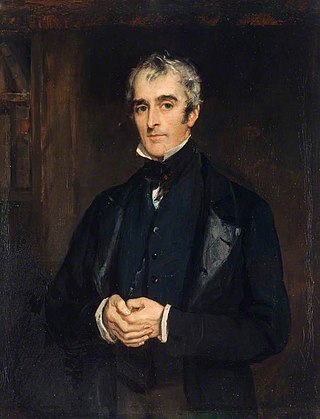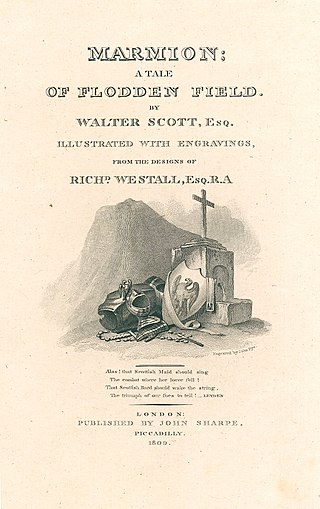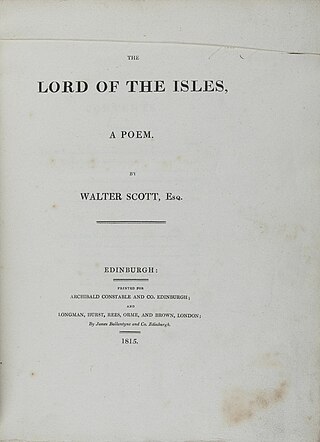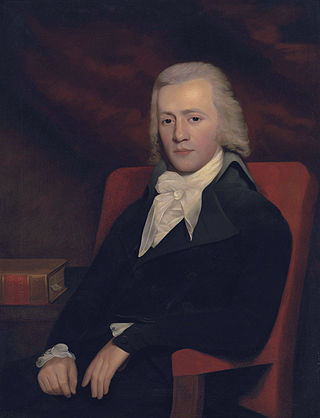
The Vision of Don Roderick is a poem in Spenserian stanzas by Sir Walter Scott, published in 1811. It celebrated the recent victories of the Duke of Wellington during the Peninsular War, and proceeds of its sale were to raise funds for Portugal.

The Vision of Don Roderick is a poem in Spenserian stanzas by Sir Walter Scott, published in 1811. It celebrated the recent victories of the Duke of Wellington during the Peninsular War, and proceeds of its sale were to raise funds for Portugal.
The Vision of Don Roderick is based on an account given by Ginés Pérez de Hita of a legendary consultation of an oracle by the last Visigothic King of Spain, Roderic, around 711: this had been a favourite of Scott's since his boyhood when he had based a four-book poem, The Conquest of Granada, on it. On 30 April 1811 Scott wrote from Ashiestiel to Lady Abercorn that he had retired to the country to compose a poem in aid of "the suffering Portuguese", and that James Ballantyne and his brother had generously promised him a hundred guineas (£105). [1] A week later he was busy with the composition and planned on completion to send the manuscript to William Erskine for vetting before it was printed. [2] On 12 May he was able to inform James Ballantyne: "A great deal of the poem is finishd at least in dead colours as the painters say for it wants much touching", [3] and the correction was almost complete by the 25th. [4] Overall, Scott seems to have found the task of composition rather burdensome. [5]
Don Roderick, camped outside of Toledo, ponders the outcome of his campaign against the Moors. After confession, he demands that the prelate lead him to a certain sealed chamber, known to be enchanted, which according to legend would reveal the future — but only to the "last" King of Spain.
When the chamber is opened, the king and prelate find themselves in a vast marble hall, with two giant bronze statues standing on either side. The left-hand giant carries a scythe and an hourglass, and the right-hand giant carries a mace. The hourglass runs out almost immediately after their entrance, and the other giant turns and demolishes the far wall with his mace, revealing a magic panorama.
The panorama depicts various phases in the future of Spain: first, the conquest by the Moors; second, the Spanish Inquisition; third, the conquest by Napoleon I of France, and the arrival of British forces to liberate the country. Such sweep fits with Scott's political agenda. [6]
The Vision of Don Roderick was published on 2 July 1811 in Edinburgh by John Ballantyne and Co., and later in the month in London by Longman, Hurst, Rees, Orme, and Brown. The price was 15s (75p). A second edition with the same date was published on 1 January 1812 in Edinburgh, and two further editions appeared in 1815 and 1821. [7]
A critical edition is due to appear in Volume 5 of The Edinburgh Edition of Walter Scott's Poetry published by Edinburgh University Press. [8]
Don Roderick was generally reckoned greatly inferior to its predecessors by most reviewers. [9] Francis Jeffrey in The Edinburgh Review is typical with his verdict that Scott 'has fewer new images than in his other poetry,—his tone is less natural and varied,—and he moves, upon the whole, with a slower and more laborious pace'. [10] The general conception of the poem was regarded as unfortunate, though there was some praise for Scott's aim to produce an elevated national work.

Sir Walter Scott, 1st Baronet, was a Scottish historian, novelist, poet, and playwright. Many of his works remain classics of European and Scottish literature, notably the novels Ivanhoe (1819), Rob Roy (1817), Waverley (1814), Old Mortality (1816), The Heart of Mid-Lothian (1818), and The Bride of Lammermoor (1819), along with the narrative poems Marmion (1808) and The Lady of the Lake (1810). He had a major impact on European and American literature.

John Gibson Lockhart was a Scottish writer and editor. He is best known as the author of the seminal, and much-admired, seven-volume biography of his father-in-law Sir Walter Scott: Memoirs of the Life of Sir Walter Scott, Bart

Archibald David Constable was a Scottish publisher, bookseller and stationer.

Marmion: A Tale of Flodden Field is a historical romance in verse of 16th-century Scotland and England by Sir Walter Scott, published in 1808. Consisting of six cantos, each with an introductory epistle, and copious antiquarian notes, it concludes with the Battle of Flodden in 1513.

The Lay of the Last Minstrel (1805) is a narrative poem in six cantos with copious antiquarian notes by Walter Scott. Set in the Scottish Borders in the mid-16th century, it is represented within the work as being sung by a minstrel late in the 1600s.

Minstrelsy of the Scottish Border is an anthology of Border ballads, together with some from north-east Scotland and a few modern literary ballads, edited by Walter Scott. It was first published by Archibald Constable in Edinburgh in 1802, but was expanded in several later editions, reaching its final state in 1830, two years before Scott's death. It includes many of the most famous Scottish ballads, such as Sir Patrick Spens, The Young Tamlane, The Twa Corbies, The Douglas Tragedy, Clerk Saunders, Kempion, The Wife of Usher's Well, The Cruel Sister, The Dæmon Lover, and Thomas the Rhymer. Scott enlisted the help of several collaborators, notably John Leyden, and found his ballads both by field research of his own and by consulting the manuscript collections of others. Controversially, in the editing of his texts he preferred literary quality over scholarly rigour, but Minstrelsy of the Scottish Border nevertheless attracted high praise from the first. It was influential both in Britain and on the Continent, and helped to decide the course of Scott's later career as a poet and novelist. In recent years it has been called "the most exciting collection of ballads ever to appear."
Nationality words link to articles with information on the nation's poetry or literature.
Nationality words link to articles with information on the nation's poetry or literature.

The Lady of the Lake is a narrative poem by Sir Walter Scott, first published in 1810. Set in the Trossachs region of Scotland, it is composed of six cantos, each of which concerns the action of a single day. There are voluminous antiquarian notes. The poem has three main plots: the contest among three men, Roderick Dhu, James Fitz-James, and Malcolm Graeme, to win the love of Ellen Douglas; the feud and reconciliation of King James V of Scotland and James Douglas; and a war between the Lowland Scots and the Highland clans. The poem was tremendously influential in the nineteenth century, and inspired the Highland Revival.

The Bridal of Triermain is a narrative poem in three cantos by Walter Scott, published anonymously in 1813. It is written in a flexible metre of four and three stress lines. Set in Cumberland, it recounts the exploits of a knight as he seeks to rescue a beautiful maiden, Gyneth, the illegitimate daughter of King Arthur, doomed by Merlin 500 years previously to an enchanted sleep inside a magic castle.
Harold the Dauntless is a narrative poem in six short cantos by Walter Scott, published in 1817. It employs a variety of metres.

The Lord of the Isles is a narrative poem by Walter Scott in six cantos with substantial notes. Set in 1307 and 1314 Scotland it covers the story of Robert the Bruce from his return from exile in Ireland to the successful culmination of his struggle to secure Scottish independence from English control at the Battle of Bannockburn. Interwoven with this account is a romantic fiction centring on one of the Bruce's prominent supporters, Ronald, Lord of the Isles, involving his love for the Bruce's sister Isabel, who eventually takes the veil, and the transfer of his affections to Edith of Lorn to whom he had been betrothed at the beginning of the poem and whom he marries at the end.
Arthur Clifford (1778–1830) was an English antiquarian.

William Erskine, Lord Kinneder (1768–1822), was a friend and confidant of Sir Walter Scott, and a scholar and songwriter.

Rokeby (1813) is a narrative poem in six cantos with voluminous antiquarian notes by Walter Scott. It is set in Teesdale during the English Civil War.

The Writers’ Museum, housed in Lady Stair's House at the Lawnmarket on the Royal Mile in Edinburgh, presents the lives of three of the foremost Scottish writers: Robert Burns, Walter Scott and Robert Louis Stevenson. Run by the City of Edinburgh Council, the collection includes portraits, works and personal objects. Beside the museum lies the Makars' Court, the country's emerging national literary monument.
The Field of Waterloo is a poem by Walter Scott, written and published in 1815. It is in iambic tetrameters and trimeters with a few Spenserian stanzas at the end. The work moves from a depiction of the site of the battle, with farm life renewing in the autumn, to an account of the conflict, highlighting Napoleon and Wellington, and a roll-call of prominent British casualties.
The Queen's Wake is a narrative poem by James Hogg, first published in 1813. It consists of an Introduction, three Nights, and a Conclusion, totalling over five thousand lines, and there are also authorial notes. The poem presents the contributions, in various metres, of a series of Scottish bards to a competition organised by Mary, Queen of Scots on her arrival in Scotland from France in 1561.
The letters of Sir Walter Scott, the novelist and poet, range in date from September 1788, when he was aged 17, to June 1832, a few weeks before his death. About 7000 letters from Scott are known, and about 6500 letters addressed to him. The major repository of both is the National Library of Scotland. H. J. C. Grierson's The Letters of Sir Walter Scott (1932–1937), though it includes only about 3500, remains the standard edition.
Illustrations of Northern Antiquities (1814), or to give its full title Illustrations of Northern Antiquities, from the Earlier Teutonic and Scandinavian Romances; Being an Abstract of the Book of Heroes, and Nibelungen Lay; with Translations of Metrical Tales, from the Old German, Danish, Swedish, and Icelandic Languages; with Notes and Dissertations, was a pioneering work of comparative literature which provided translations and abstracts of various works written in medieval Germany and Scandinavia. Its three authors were Henry Weber, who précised the Nibelungenlied and Heldenbuch; Robert Jamieson, who translated Danish and other ballads, stressing their close connection with Scottish ballads; and Walter Scott, who provided an abstract of Eyrbyggja saga. It significantly extended British readers' access to early Germanic literature.